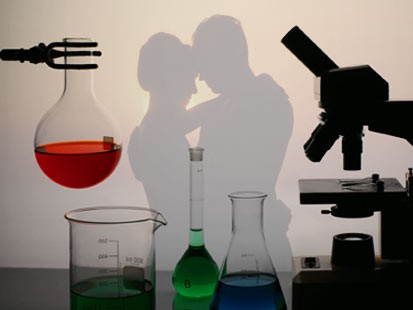By: Kelsey Pinault (University of Miami)
Follow Kelsey on Twitter

Love among young adults these days can have a variety of meanings. What once meant a sacred bond between two people can now be dumbed down to sharing a liking for the same bands. What many don’t know however, no matter their age, is that love is not the feeling in your heart or head or mixture of the two. Love is science.
The yearning to fall in love time and time again is one that will never die. From the roses on sale year-round at Publix to the day dedicated strictly to love, it is clear that people of all customs share that one thing in common. But in terms of science- what is love? Why do we get butterflies? How does one person make you feel like your stomach is on a rollercoaster only hours, if not minutes, after meeting them?
When someone of interest catches your eye from across the room, the first thing you assess is their looks and body language. Whether or not you admit to being superficial, when it comes to sizing up your potential relationship with someone, looks matter; What you might not realize, however, is that so do sound and smell. Studies show that men and women are driven to be attracted to a certain body type, from head to toe, and voice to musk. Females see a man with broad shoulders and a deep voice as a promising child rearing partner because of the high testosterone levels the qualities represent. Males prefer women with a larger bust and low waist-to-hip ratio which signals fertility. Without realizing it, men seem to find women who are ovulating (a stage in the cycle in which the female is most fertile) to be most attractive. Scientists think this may be linked to the scent women give off at this time, telling men they are prime to conceive (not usually what us girls think of when applying our perfume).
![]()
After the initial attraction is under way, the light-headed high you get from “falling in love” is actually a series of chemical reactions in the body. Helen Fisher of Rutgers University has become known as quite an expert on the subject. She explains that we fall in love in three stages. The first stage, lust, is driven by the two sex hormones testosterone and estrogen. The next stage is attraction, involving three neuro-transmitters, one being dopamine, which is also activated by cocaine, meaning a brain in love is similar to that of one under the influence. That last stage of love is attachment. Although the body is told to find a mate in order to pass on its genes, the mind and society tells us to want something more. So after the initial excitement wears off, a relationship needs a special bond in order to properly raise children.

Although psychologists admit we still have a lot to learn about the science of love, it is becoming increasingly clear that love is not actually a feeling we dreamt up. Instead it’s a plan our body has to successfully mate, complete with gene analysis and chemical transformations. So, the next time you’re looking for a cutie at the bar, keep in mind that your body has other plans.


